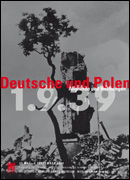


Exhibition | Oppression and Self-assertion | War and Occupation | Conflicts and Rapprochements
The Partitions of Poland
| Struggle for Freedom and Enthusiasm for Poland
Intensification of the "Germanization policy"
World War One and the Reconstitution of Poland
Border Conflicts and Demonization
| A Calculated Rapprochement
After taking power in 1933, the Nazis initiated a rapprochement with Poland for tactical reasons. The Polish-German Non-Aggression Treaty of 1934 represented a radical break from the Weimar Republic's anti-Polish revisionist policy. The German press was instructed to stop reporting about the repression of Poland's German minority. This policy was echoed in Warsaw as well, and economic and cultural contacts between Germany and Poland were revived.
This calculated rapprochement came to an end in the winter of 1938/39, when Poland became the focus of the Nazis' expansionist policy. Polish-German tensions were exacerbated by the increasingly aggressive and confrontational posture of the Nazi leadership.
In April 1939, the German army began to prepare for war with Poland. The “Hitler-Stalin-Pact” of 23 August 1939 defined the German and Soviet spheres of interest, opening the door to a joint invasion of Poland.
